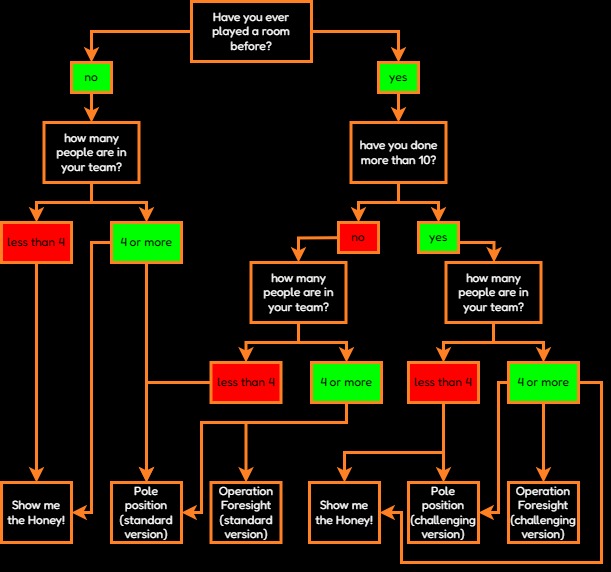Not sure which of our rooms to play? Never played before and don’t know where to start? Here’s all you need to know about the types of games we offer! Use the chart to find which room we’d recommend for your group!

Understanding our games
At the top of each room page, you’ll find information boxes about the game. If you’re not sure what any of it means, you can find more information below
Choose your difficulty:
Standard – recommended for players who have done 0-10 rooms, are a small team, or have younger players.
Challenging – recommended for players who have done 10+ rooms, or are a larger team.
All first time players should opt for standard difficulty.
The main game is the same, however the puzzles are more complex, and there’s usually a few extra in the challenging version compared to the standard. In standard, the GM might provide clues at periodic points, whereas in challenging they’ll usually ask first or wait for you to ask.
The difficulty rating is how complex we feel the game is in comparison to our other games.
We recommend new players start with our lowest rated rooms and work up to the higher rated rooms.
The min. age is our recommendation based on how complex we feel the puzzles are, and how much enjoyment we feel you’ll get from the room. All rooms are suitable for adults.
We only recommend challenging versions to adults or experienced teens.
The min. age recommendation is for mixed groups of adults and children. We’d recommend adding 2 years onto the min. age for groups of only children.
Linear
The game only has a singular line of puzzles, meaning you can only solve one thing at a time. Each puzzle will lead to the next so you won’t have to spend too much time looking around for what to do next.
Multi-linear
The game has 2 or 3 main ‘paths’ to complete the final objective, so your team can split up and work on different things. The paths may cross-over at points or merge into a single path and split again.
Non-linear
The game has lots of different paths and a more free-flow layout. Everything you solve will still lead to one final objective, but how you get there is up to you!
Low
There’s basic level reading and written instructions. Suitable for younger children and non-native speakers. Please note all our games require a basic grasp of the English language.
Medium
Slightly more reading including some written/word based puzzles. Suitable for older children and recommended for players with a reasonable grasp of the English language.
High
A fair amount of written instructions and puzzles to follow. Players should be fluent in English and should be willing and able to read thoroughly.
Audio over intercom
When you ask for or are provided a clue from the games master, you’ll hear them being spoken through the intercom. You’ll be able to more easily converse with the games master, however you’ll have to listen carefully whilst its being given.
Text on a screen
When you ask for or are provided with clues from the games master, they will appear as text on a TV screen. They may take a tiny bit longer to come through, but they’ll stay up on the screen until you’ve finished with it.
Puzzle types
Below are the types of puzzles you might find in each room, and what kind of tasks they might involve
Visual
Copying images, clues within pictures, comparing images, creating patterns
Maths
Basic addition or subtraction, percentages, currency conversion
Tactile
Construction, interacting with characters, navigating mazes, throwing objects
Counting
Counting objects, sequences, number puzzles that don’t involve maths
Written
Clues within text, riddles, logic puzzles, crosswords, extracting info
Searching
Hidden objects, collecting multiple pieces of one puzzle, obscured clues
Spelling
Anagrams, hangman, missing letters, letter extraction
Ciphers
Coded messages, mystery symbols, translations, morse code